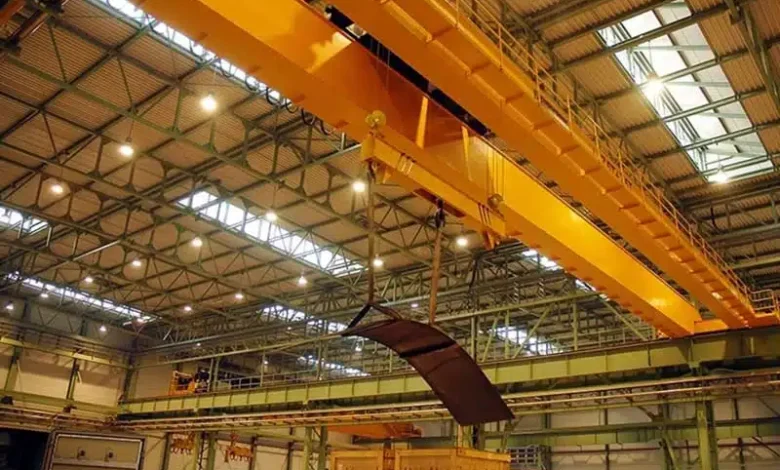How Overhead Cranes Contribute to Warehouse Efficiency and Productivity

Overhead cranes are indispensable tools in industrial settings, especially in warehouses where heavy lifting and material handling are daily tasks. These cranes are designed to lift, move, and position heavy loads with precision and efficiency. In warehouses, where space is often limited and operations demand speed, overhead crane offer a solution that enhances both productivity and safety.
In this article, we will explore how overhead cranes improve warehouse efficiency, streamline operations, reduce costs, and increase safety. By understanding the numerous ways in which these cranes contribute to warehouse productivity, businesses can optimize their operations and enhance overall efficiency.
1. Space Optimization
Warehouses often face space constraints, especially as inventory grows and product movement becomes more complex. Overhead cranes help address these challenges by utilizing the vertical space in a warehouse, freeing up valuable floor space that would otherwise be occupied by forklifts or other material handling equipment.
How Overhead Cranes Optimize Space:
-
Utilizing Vertical Space: Unlike ground-based equipment, overhead cranes run along tracks mounted above the warehouse floor, allowing them to move materials across the ceiling and not obstruct ground-level operations. This use of vertical space maximizes the available storage area for products and equipment, freeing up the floor for additional shelving, inventory, or workstations.
-
No Obstruction in Aisles: Since the crane’s movement is overhead, it doesn’t block aisles or pathways that other material handling equipment, such as forklifts, might. This reduces congestion and ensures smoother, more efficient movement of goods in the warehouse.
By using the overhead space for material handling, warehouse managers can maximize storage space and increase storage density without compromising the efficiency of their operations.
2. Improved Material Handling and Load Movement
One of the most obvious benefits of overhead cranes in a warehouse is their ability to handle and move heavy or bulky materials with ease. These cranes can carry large, awkward loads that would otherwise require multiple workers or specialized equipment.
Benefits of Overhead Cranes in Load Handling:
-
Heavy Load Capacity: Overhead cranes are designed to lift heavy loads with high precision, whether it’s machinery, large packages, or construction materials. This capability is particularly important in warehouses that handle large or industrial products, as manual lifting can be inefficient and risky.
-
Safe and Efficient Movement: Cranes can transport materials across long distances within the warehouse, such as from receiving docks to storage areas, or from storage to packing and shipping areas. This minimizes the time spent moving materials manually and eliminates the need for forklifts or pallet jacks, which can take up significant floor space and require more labor.
-
Minimized Manual Labor: By automating the lifting and transporting process, overhead cranes reduce the physical demands on warehouse staff, allowing them to focus on tasks that require more attention to detail. This reduction in manual labor also decreases the risk of workplace injuries from lifting heavy or awkward loads.
Overhead cranes enhance the speed and accuracy of material handling, significantly boosting the overall productivity of the warehouse.
3. Increased Productivity with Faster Load Transfers
Time is a critical factor in warehouse operations. The faster goods can be moved from one area to another, the more products can be handled in a given time frame, ultimately improving productivity.
How Overhead Cranes Speed Up Operations:
-
Quick and Efficient Loading/Unloading: Overhead cranes allow for faster loading and unloading of goods, as they can quickly lift and transport materials across the warehouse. This reduces the time spent waiting for forklifts or other equipment to maneuver, enabling a more efficient workflow.
-
Reduced Downtime: Since cranes are faster and can be used continuously without taking breaks, they reduce downtime during material handling processes. For example, while workers can load goods into a truck using a crane, the operator can also prepare the next load in parallel, optimizing time.
Faster transfers and reduced waiting times lead to improved throughput in the warehouse, which directly contributes to enhanced productivity.
4. Enhanced Safety and Reduced Risk of Workplace Injuries
Safety is one of the top priorities in any warehouse environment. Overhead cranes play a significant role in enhancing worker safety by eliminating many of the risks associated with manual material handling.
How Overhead Cranes Improve Safety:
-
Reduced Manual Lifting: One of the most common causes of workplace injuries in warehouses is improper manual lifting. By taking over the heavy lifting tasks, overhead cranes help prevent injuries such as strains, sprains, and back problems. Workers no longer need to lift or move heavy items manually, which greatly reduces the risk of accidents.
-
Preventing Dropped Loads: Overhead cranes are equipped with safety features such as load limiters, emergency stops, and secure lifting mechanisms that help prevent dropped loads, a major cause of accidents. When used properly, cranes ensure that loads remain secure throughout their journey across the warehouse.
-
Operator Safety: Crane operators are usually in a well-protected cabin or control area, far away from the load they are moving. This isolation from the actual load movement minimizes their exposure to any potential dangers, providing an additional layer of safety.
The increased safety afforded by overhead crane means fewer injuries, less downtime, and improved morale among workers.
5. Reduced Equipment Wear and Tear
In busy warehouse environments, equipment is often put to the test. Forklifts and other ground-based machinery face wear and tear over time, requiring frequent maintenance and repair. Overhead cranes, on the other hand, tend to have fewer mechanical issues and a longer lifespan due to their relatively simple design and efficient operation.
Benefits of Overhead Cranes for Equipment Longevity:
-
Less Wear on Ground Equipment: With an overhead crane handling heavy loads, warehouse forklifts and other vehicles are freed up for other tasks, reducing their wear and tear. This allows forklifts to last longer and reduces the frequency of maintenance or repair, lowering overall operational costs.
-
Durability of Cranes: Overhead cranes are designed for heavy-duty operations, and their robust construction typically means they experience less wear and tear compared to other types of material handling equipment. Regular maintenance and inspections will ensure the crane continues to perform optimally for years.
By reducing the strain on other equipment and ensuring that the crane itself remains in good working condition, warehouses can save on repair and replacement costs.
6. Increased Inventory Accuracy
Inventory management is a critical part of warehouse operations. Inaccurate inventory tracking can lead to stockouts, overstocking, and inefficiencies in fulfilling orders. Overhead cranes contribute to better inventory control by ensuring materials are moved and stored with accuracy.
How Overhead Cranes Improve Inventory Management:
-
Precise Placement of Goods: Overhead cranes allow for precise positioning of goods in designated storage areas. This accuracy prevents misplaced items and ensures that stock levels are accurate, reducing the chances of errors in inventory counts.
-
Less Handling of Products: Overhead cranes reduce the handling of products, which minimizes the potential for errors in order fulfillment. With fewer hands touching the inventory, the chances of mistakes are reduced, leading to improved stock management and better order accuracy.
With overhead cranes, warehouses can maintain more accurate records, ensuring that inventory levels are up-to-date and order fulfillment is streamlined.
7. Energy Efficiency
Energy consumption is a significant factor in warehouse operations, and overhead cranes are designed to operate with energy efficiency in mind. These cranes can be equipped with energy-saving technologies that reduce electricity usage while maintaining optimal performance.
How Overhead Cranes Contribute to Energy Efficiency:
-
Electric Powered Cranes: Many modern overhead cranes are powered by electric motors, which are more energy-efficient than other types of power sources like gas or diesel engines. These cranes can be operated with minimal energy consumption while still offering high performance.
-
Regenerative Drive Systems: Some overhead cranes use regenerative drive systems, which capture energy during braking and return it to the system, further reducing energy use.
By investing in energy-efficient overhead cranes, warehouses can reduce their energy costs and contribute to a more sustainable operation.
Conclusion
Overhead cranes play a critical role in improving warehouse efficiency and productivity. By utilizing vertical space, enhancing load handling, speeding up operations, and improving safety, these cranes offer numerous benefits for warehouse managers. Additionally, they help reduce the risk of workplace injuries, lower equipment maintenance costs, and ensure greater inventory accuracy.
By investing in the right overhead crane system and implementing the necessary safety protocols, warehouses can enhance their operational efficiency, reduce downtime, and create a safer working environment for their employees. With the right tools in place, warehouses can meet the increasing demands of modern logistics while maintaining high standards of productivity and safety.



